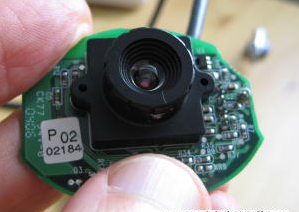 |
| Principle of WebCam |
Principle of a WebCam / CCD (charge-coupled devices) :
After removing outer case of a webcam you'll find it's little more than a plastic lens mounted directly onto a tiny electronic circuit board underneath . The lens screws in and out to increase its focal length , controlling the focus of your WebCam : |
| After Removing Case |
 |
| Micro Chip |
How does a CCD convert an image to digital form?
When you capture a digital photo or stare into your webcam , light zooms into the cam lens . This incoming "picture" hits the CCD , which breaks it up into individual pixels . The CCD measures how much light is hitting at each pixel . This information is turned into a number that can be stored on a memory chip inside the camera . Thus , taking a digital photograph converts the picture you see into a very long string of binary numbers . Each number describes one pixel in the image - how bright or dark and which color it is .
Steps :
- Light from the object (in this case ,here is a bicycle) enters in the camera lens .
- The CCD inside the camera splits the image up into millions of pixels (squares). An LCD(Liquid Cristal Display) display on the back of the camera shows you a image that the CCD is capturing -- not an image of the object seen through a series of lenses ( as with a conventional camera ) , but a redrawn , computerized version of the original object displayed on a screen .
- The CCD measures the color and brightness of each pixel .
- The color and brightness are stored as binary numbers , patterns of zeros and ones , in the camera's flash memory card . When you connect your camera to a computer , these numbers are transmitted instantly down the wire .

The CCD was invented in the year 1969 by Canadian-born Willard S. Boyle and American George E. Smith , two colleagues working at Bell Laboratories.
The scientific theory behind the CCD (turning light energy into electrical energy) dates back much further - to 1905. Known as the photoelectric effect , it was the first major scientific discovery by Albert Einstein .

No comments:
Post a Comment